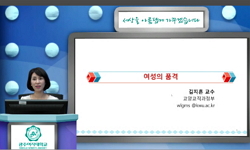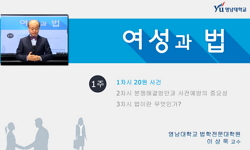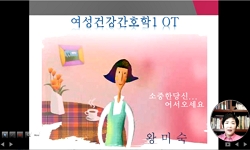In this paper, I would like to pay more attention to female characters among the characters of Pilgi and Yadam that many previous studies have paid attention to. The subject will be focused on the handwriting of Joseon Dynasty, and will limit the disc...
http://chineseinput.net/에서 pinyin(병음)방식으로 중국어를 변환할 수 있습니다.
변환된 중국어를 복사하여 사용하시면 됩니다.
- 中文 을 입력하시려면 zhongwen을 입력하시고 space를누르시면됩니다.
- 北京 을 입력하시려면 beijing을 입력하시고 space를 누르시면 됩니다.
 OpenAccess
OpenAccess
15, 16세기 필기에 나타난 여성 인물의 내면과 자의식 = The Inner and Self-consciousness of Female characters in Pilgi in the 15th and 16th centuries
한글로보기https://www.riss.kr/link?id=A105963973
-
저자
신상필 (부산대학교)
- 발행기관
- 학술지명
- 권호사항
-
발행연도
2018
-
작성언어
Korean
-
주제어
Pilgi ; Yadam ; The end of Koryo Dynasty and Early Joseon Dynasty ; Middle of Joseon period ; female ; Sub-subject ; frame ; 필기 ; 야담 ; 여말선초 ; 조선중기 ; 여성 ; 하위주체 ; 프레임
-
등재정보
KCI등재
-
자료형태
학술저널
- 발행기관 URL
-
수록면
37-65(29쪽)
-
KCI 피인용횟수
0
- DOI식별코드
- 제공처
-
0
상세조회 -
0
다운로드
부가정보
다국어 초록 (Multilingual Abstract)
The writer is interested in his colleagues through the stylistic frame of literature in that he basically records the interest of the bureaucrats and the bureaucrats, the swordsmen of the monks. Nevertheless, I would like to note the fact that they have captured the unique characters around them. At this time, though it is rare, human groups of various orders reveal their faces and voices, and the presence of women, one of the strata that have not been noticed in society, sometimes appears as if they are rubbed. And when we look at the stylistic frame of writing, these women's aspects show the voices of self awareness and practical behavior as the lower layer of the oil society, and we will pay attention to the sub–subject.
Of course, these female subordinate subjects have come to the record to ring the men and women of Confucian society. Nevertheless, on the other side of the record, the voice of "affirmation for human lust" of female subordinate subjects is intact. In fact, the issue of lust is shared by men and women, but differences in degree are subject to social sanctions, and especially emphasized by women. But we have a duty to cherish our voices to survive in such emphasis, coercion, and the social structure of our exaltation. In the aftermath of this social wave, I would like to discover the logic and voice of the interesting transformational ideas of female sub-subjects.
In this paper, I would like to pay more attention to female characters among the characters of Pilgi and Yadam that many previous studies have paid attention to. The subject will be focused on the handwriting of Joseon Dynasty, and will limit the discussion with 「eouyadam(於于野談)」, who announced the beginning of the story. In the latter period of the Joseon Dynasty, where socioeconomic conditions developed, Pilgi and Yadam are fascinating in that they provide various types of figures along with the strengthening of narrative. However, it is to be noted that the vivid characters of women can be identified in the Pilgi and Yadam of the Joseon Dynasty, which is the center of the 15th and 16th centuries.
The writer is interested in his colleagues through the stylistic frame of literature in that he basically records the interest of the bureaucrats and the bureaucrats, the swordsmen of the monks. Nevertheless, I would like to note the fact that they have captured the unique characters around them. At this time, though it is rare, human groups of various orders reveal their faces and voices, and the presence of women, one of the strata that have not been noticed in society, sometimes appears as if they are rubbed. And when we look at the stylistic frame of writing, these women's aspects show the voices of self awareness and practical behavior as the lower layer of the oil society, and we will pay attention to the sub–subject.
Of course, these female subordinate subjects have come to the record to ring the men and women of Confucian society. Nevertheless, on the other side of the record, the voice of "affirmation for human lust" of female subordinate subjects is intact. In fact, the issue of lust is shared by men and women, but differences in degree are subject to social sanctions, and especially emphasized by women. But we have a duty to cherish our voices to survive in such emphasis, coercion, and the social structure of our exaltation. In the aftermath of this social wave, I would like to discover the logic and voice of the interesting transformational ideas of female sub-subjects.
국문 초록 (Abstract)
필기는 기본적으로 사대부라는 문인지식층이자 관료들의 관심사를 기록했다는 점에서 그 양식적 프레임을 통해 자신의 동료들에 주목하였다. 이는 남성의 시각과 목소리를 대변한다는 의미이기도 하다. 이때 그들 주변의 독특한 인물들을 포착한 사실에 유의하려 한다. 드물기는 하지만 다양한 인물들이 얼굴과 목소리를 드러내며, 사회적 주목을 받지 못했던 여성의 존재도 등장하기 때문이다. 다만 필기의 양식적 프레임을 걷어내고 볼 때, 유가 사회의 하층이었던 여성의 목소리와 행동이 비로소 드러난다.
물론 이들 여성 하위주체들은 유교 사회의 남녀에게 경종을 울리고자 기록에 오른 것이다. 그럼에도 그 기록의 한편에는 여성 하위주체들의 ‘인간 정욕에 대한 긍정’의 목소리가 고스란히 담겨 있다. 사실 정욕의 문제는 남녀가 공유하는 것이고, 다만 정도의 차이가 사회의 제재를 받는 것이며 하필 여성에게 특별하게 강조되었다. 그렇지만 우리는 그러한 강조와 강압, 그리고 회유의 사회적 구조 속에서 살아남기 위한 자그만 목소리와 모습들을 소중하게 보듬어 갈무리할 의무가 있다. 그리고 이와 같은 기울어진 사회적 구조 속에서 하위주체였던 여성들이 흥미로운 전환적 발상의 논리와 목소리를 통해 상층 필기 양식에 틈입하여 균열을 내는 장면들을 발견하고자 한다.
본고는 많은 선행연구들이 주목하였던 필기의 인물들 가운데 15, 16세기의 여성 인물에 다시 관심을 가져보고자 한다. 조선전기의 필기집을 중심으로 살피면서, 야담의 서막을 열었으나 아직...
본고는 많은 선행연구들이 주목하였던 필기의 인물들 가운데 15, 16세기의 여성 인물에 다시 관심을 가져보고자 한다. 조선전기의 필기집을 중심으로 살피면서, 야담의 서막을 열었으나 아직 필기적 성향이 강한 『어우야담』을 대상으로 논의를 한정할 것이다. 사회경제적 조건이 발달한 조선후기의 경우 필기와 야담은 서사성의 강화와 함께 다양한 인물유형을 제공한다는 점에서 매혹적이다. 하지만 15, 16세기가 중심인 조선전기의 필기 양식에서도 생생한 여성 인물들의 모습과 목소리를 확인할 수 있다는 점에 특기하고자 한다.
필기는 기본적으로 사대부라는 문인지식층이자 관료들의 관심사를 기록했다는 점에서 그 양식적 프레임을 통해 자신의 동료들에 주목하였다. 이는 남성의 시각과 목소리를 대변한다는 의미이기도 하다. 이때 그들 주변의 독특한 인물들을 포착한 사실에 유의하려 한다. 드물기는 하지만 다양한 인물들이 얼굴과 목소리를 드러내며, 사회적 주목을 받지 못했던 여성의 존재도 등장하기 때문이다. 다만 필기의 양식적 프레임을 걷어내고 볼 때, 유가 사회의 하층이었던 여성의 목소리와 행동이 비로소 드러난다.
물론 이들 여성 하위주체들은 유교 사회의 남녀에게 경종을 울리고자 기록에 오른 것이다. 그럼에도 그 기록의 한편에는 여성 하위주체들의 ‘인간 정욕에 대한 긍정’의 목소리가 고스란히 담겨 있다. 사실 정욕의 문제는 남녀가 공유하는 것이고, 다만 정도의 차이가 사회의 제재를 받는 것이며 하필 여성에게 특별하게 강조되었다. 그렇지만 우리는 그러한 강조와 강압, 그리고 회유의 사회적 구조 속에서 살아남기 위한 자그만 목소리와 모습들을 소중하게 보듬어 갈무리할 의무가 있다. 그리고 이와 같은 기울어진 사회적 구조 속에서 하위주체였던 여성들이 흥미로운 전환적 발상의 논리와 목소리를 통해 상층 필기 양식에 틈입하여 균열을 내는 장면들을 발견하고자 한다.
참고문헌 (Reference)
1 이우성, "李朝漢文短篇集 上·中·下" 일조각 1989
2 신상필, "필기의 서사화 양상에 관한 연구 : 『용재총화』와 『어우야담』을 중심으로" 성균관대학교 대학원 2005
3 박희병, "조선후기 전의 소설적 성향 연구" 성균관대학교출판 1-454, 1993
4 이주영, "조선후기 야담에 나타난 여성 정욕의 표출과 그 대응의 몇 국면" 한국고전연구학회 (41) : 103-133, 2018
5 徐居正, "역주 태평한화골계전" 태학사 1998
6 최기숙, "여성성의 재발견 : 이성, 지혜, 성공의 탈영토화" 한국고전여성문학회 (6) : 193-230, 2003
7 이강옥, "야담에 나타나는 여성 정욕의 실현과 서술 방식" 한국고전여성문학회 (16) : 175-218, 2008
8 정명기, "야담문학연구의 현단계 1·2·3" 보고사 2001
9 곽미라, "고려시대 인물기술의 한 양상 -『櫟翁稗說』의 경우 -" 국제어문학회 (60) : 301-327, 2014
10 崔滋, "고려명현집 2" 성균관대학교 대동문화연구원 1986
1 이우성, "李朝漢文短篇集 上·中·下" 일조각 1989
2 신상필, "필기의 서사화 양상에 관한 연구 : 『용재총화』와 『어우야담』을 중심으로" 성균관대학교 대학원 2005
3 박희병, "조선후기 전의 소설적 성향 연구" 성균관대학교출판 1-454, 1993
4 이주영, "조선후기 야담에 나타난 여성 정욕의 표출과 그 대응의 몇 국면" 한국고전연구학회 (41) : 103-133, 2018
5 徐居正, "역주 태평한화골계전" 태학사 1998
6 최기숙, "여성성의 재발견 : 이성, 지혜, 성공의 탈영토화" 한국고전여성문학회 (6) : 193-230, 2003
7 이강옥, "야담에 나타나는 여성 정욕의 실현과 서술 방식" 한국고전여성문학회 (16) : 175-218, 2008
8 정명기, "야담문학연구의 현단계 1·2·3" 보고사 2001
9 곽미라, "고려시대 인물기술의 한 양상 -『櫟翁稗說』의 경우 -" 국제어문학회 (60) : 301-327, 2014
10 崔滋, "고려명현집 2" 성균관대학교 대동문화연구원 1986
11 임형택, "韓國文學史의 視角" 창작과비평사 1-486, 1984
12 柳夢寅, "於于野談" 돌베개 2006
13 김기림, "『공사견문록』의 여성유형과 여성생활사 측면에서 본 의의" 동양고전학회 (48) : 117-145, 2012
14 이승은, "『雜記古談』 <奇奴> 연구 -인물형상과 ‘奇’의 의미-" 우리어문학회 (53) : 235-263, 2015
15 이신성, "<양은천미> 소재 여성인물야담에 대하여" 8 : 145-170, 1994
16 申仙姬, "<於于野談>에 나타난 女性人物의 樣相" 2 : 232-259, 1996
동일학술지(권/호) 다른 논문
-
- 한국고전여성문학회
- 한혜원
- 2018
- KCI등재
-
조선 초기 자녀안(恣女案)의 적용 사례에 대한 연구- 김정경(金定卿)의 처 왕씨(王氏)의 예
- 한국고전여성문학회
- 강명관
- 2018
- KCI등재
-
조선후기 여성영웅소설 <정수정전> 재고: 여성 인물의 행위자성을 중심으로
- 한국고전여성문학회
- 전기화
- 2018
- KCI등재
-
- 한국고전여성문학회
- 전지원
- 2018
- KCI등재
분석정보
인용정보 인용지수 설명보기
학술지 이력
| 연월일 | 이력구분 | 이력상세 | 등재구분 |
|---|---|---|---|
| 2026 | 평가예정 | 재인증평가 신청대상 (재인증) | |
| 2020-01-01 | 평가 | 등재학술지 유지 (재인증) |  |
| 2017-01-01 | 평가 | 등재학술지 유지 (계속평가) |  |
| 2016-02-15 | 학술지명변경 | 외국어명 : 미등록 -> Korean Classical Woman Literature Studies |  |
| 2013-01-01 | 평가 | 등재학술지 유지 (등재유지) |  |
| 2010-01-01 | 평가 | 등재학술지 유지 (등재유지) |  |
| 2007-01-01 | 평가 | 등재학술지 선정 (등재후보2차) |  |
| 2006-01-01 | 평가 | 등재후보 1차 PASS (등재후보1차) |  |
| 2004-01-01 | 평가 | 등재후보학술지 선정 (신규평가) |  |
학술지 인용정보
| 기준연도 | WOS-KCI 통합IF(2년) | KCIF(2년) | KCIF(3년) |
|---|---|---|---|
| 2016 | 0.92 | 0.92 | 0.97 |
| KCIF(4년) | KCIF(5년) | 중심성지수(3년) | 즉시성지수 |
| 1.04 | 0.99 | 2.523 | 0.27 |




 KCI
KCI 스콜라
스콜라






